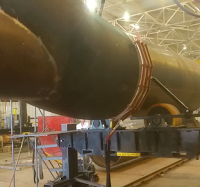 |
| Interior view of heat treating furnace. |
Heat treating includes stress-relief treating, normalizing, annealing, austenitizing, hardening, quenching, tempering, martempering, austempering, and cold treating. Annealing, as an example, involves heating a metallic material to, and holding it at, a suitable temperature, followed by furnace cooling at an appropriate rate. Steel castings may be annealed to facilitate cold working or machining, to improve mechanical or electrical properties, or to promote dimensional stability. Steel vessels, girders, pipes, and structures are heat treated prior to, and after welding to improve weld quality and strength.
 |
| Gas fired furnace used for heat treating. |
Heating systems are direct fired or indirect heated. With direct-fired furnace equipment, work being processed is directly exposed to the products of combustion, generally referred to as flue products. Gas- and oil-fired furnaces are the most common types of heat treating equipment. Indirect heating is performed in electrically heated furnaces and radiant-tube-heated furnaces with gas-fired tubes, oil-fired tubes, or electrically heated tubes.





